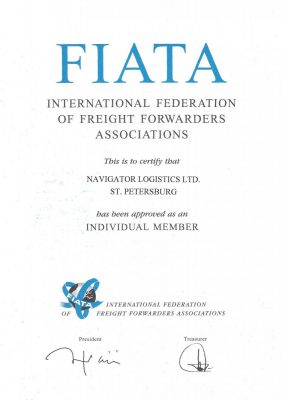Standardization of cargoes plays an important role among the ways to solve the issue of speed increase, reliability and cost effectiveness of international transportations. Standardization is achieved by combining small packages to a size that allows to use mechanized, computerized or automatic loading and unloading equipment; by the use of packages with overall dimensions which are standard in all countries participating in the transportation; by the use of special standardized means of transport (for example, trailers) or means of transport intended for the carriage of standard packages (r/w platforms for containers).
Today the main means of cargo standardization are pallets, containers and trailers.
Small packages of goods are combined on a pallet in a standardized unit secured with the help of a wide metal or plastic tape, or are placed in a package made of fibre board and secured with a steel tape or are wrapped with a shrink plastic film directly on the pallet. On the one hand these measures reduce the risk of loss or theft of individual packages of goods; on the other hand they allow to load and upload goods by the standard fork lifter and to avoid laying small packages manually.
There are a few basic standard pallet sizes: railway pallet (800х1200), euro-pallet (600х1200), marine pallet recommended by ISO (1000 x1200) and marine container pallet used in Japan and Australia (1100х1100).
Unfortunately, it is still possible to encounter the use of pallets not corresponding to the international standards. Thus pallets arriving with goods from China are very often impossible to unload with a standard loader. They can not be used in the future as well – when exporting goods from Russia.
The main standard container sizes recommended by ISO are a 20-foot container (length 6.1 m, accommodates 11 euro-pallets) and a 40-feet container (length 12.2 m, accommodates 22 euro-pallets). About 85% of the global fleet accrue to standard dry cargo containers. In the U.S. containers of standard length are used but their length is increased from standard 2.4 m to 2.9 m. And only 2% of containers in the world have length that is not equal to 6.1m or 12.2 m (for example, a 10-foot container- length 3.05 m).
Container transportations service a significant share of goods going for export. Unlike in the case with pallets, China uses mostly standardized containers for international transportations, which significantly facilitates organization of trade turnover between our countries.
In the sphere of international motor transportations cargoes are standardized using trailers of two main sizes. Trailers with length of body 14.6 m are the equivalent of wagon load and allow to simply calculate the required number of transport when repacking cargo from a railway train to a truck train. Trailers with length of body 8.5 m are used for small shipments. When trailer sizes are smaller, the number of intermediate selections at the warehouses of freight forwarders is reduced, as well as the time of cargo lot consolidation, sufficient to fill the volume of the trailer body.
When locked and securely sealed containers or trailers are used as standardized means of transport it significantly reduces the possibility of petty theft of cargo during its transportation. Reliable care of containers or trailers (excluding their serious defects or damages of locks) and attention to sealing – these are the guarantees of safety of your goods.
Navigator Logistic Company will never offer the clients a defective or damaged container or trailer. All means of standardization of cargo that we use conform to international standards and world practice of transportation. This means that your cargo will always be delivered safely and on time.
